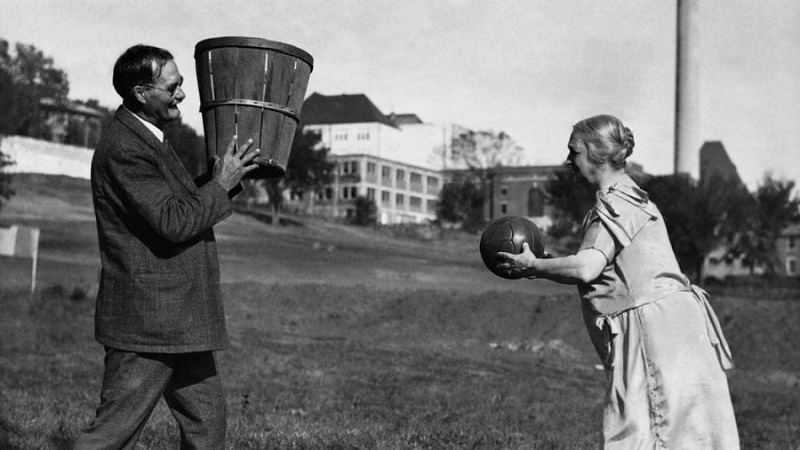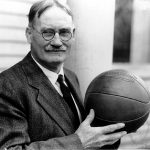Dr. James Naismith, the founder of Basketball
Who Invented Basketball?
Dr. James Naismith, a Canadian physical educator, created basketball in 1891. Today Basketball is the second most popular sport on the planet (after football, or “soccer”). In a way, it has its own culture. Its own language, style, and community. Basketball is a phenomenon that brings people of different cultures together. All of them have one thing in common, their love for the game. When it comes to basketball, fans want to learn any and everything they can about the game. People analyze statistics, teams, players, anything we could find. While we know so much about the game, some of us don’t know the origins. We don’t know the answers to questions such as “What is the origin of basketball? “or “Who invented basketball?”. Both questions involve one man: Dr.James Naismith.
The early life of James Naismith
James Naismith is the inventor of basketball, the game that we know and love today. His story began in 1861. James Naismith was born November 6th, 1861, in Almonte, Ontario, Canada, to Scottish immigrants. He became an orphan at the age of 9 after losing his parents John and Margaret Naismith, to typhoid fever. His uncle raised him during the rest of his adolescence. As a kid, James Naismith was athletic and strong. When he wasn’t doing farm work, he would play outside. His favorite activities included hide-and-seek and a game called “duck on the rock,” which was like tag. Naismith attended McGill University in Quebec, where he received a degree in Physical Education. He also received a diploma at the Presbyterian College in Montreal. After graduating, Naismith taught physical education at McGill and became their director of athletics. Then, he left Montreal to teach physical education at the YMCA International Training College in Springfield, Massachusetts. In 1954 it changed the name to Springfield College.
Origins of basketball
Dr.James Naismith invented basketball while at the YMCA Training College in Springfield. Dr. Luther Gulick, the head of Physical Education at the Y, gave Naismith 14 days to create an indoor game to keep students “interested.” Indoor activities at the YMCA consisted of gymnastics. Outdoor activities such as football were more popular, but they could not play them during the winter. Gulick told Naismith to create a game free of rough play. James Naismith remembered a game from his childhood, “duck on the rock.” In “duck on the rock,” players formed a line 15-20 feet away from a base stone. Each player had a fist-sized stone they used to dislodge the “guards” stone from the top of the base stone by taking turns throwing their stone. Players were chased and tagged if they missed the “guards” stone. While trying to invent a new game, James Naismith took some aspects from this childhood game.
The History of Basketball Takes Shape
 Dr. James Naismith studied other popular games of the time, like football and lacrosse. As a result, he noticed that larger balls didn’t move as well as smaller balls. Therefore, he decided that a soccer ball was the best choice to use. Also, Naismith decided to place the game’s goal above the players. This way, the goal wasn’t guarded. The overhead goal was less physical than other games. Finally, James Naismith needed a way for players to score. For that, he used an aspect from “duck on the rock.” He remembered the lobbed arcing shots used to hit the “guards” stone. Consequently, he decided to use the arcing shot in his new game. Finally, the first basketball game took place in December 1891 in Springfield, Massachusetts. Peach baskets were the goals that players scored in. James Naismith also created a list of 13 original rules of basketball to go along with the game.
Dr. James Naismith studied other popular games of the time, like football and lacrosse. As a result, he noticed that larger balls didn’t move as well as smaller balls. Therefore, he decided that a soccer ball was the best choice to use. Also, Naismith decided to place the game’s goal above the players. This way, the goal wasn’t guarded. The overhead goal was less physical than other games. Finally, James Naismith needed a way for players to score. For that, he used an aspect from “duck on the rock.” He remembered the lobbed arcing shots used to hit the “guards” stone. Consequently, he decided to use the arcing shot in his new game. Finally, the first basketball game took place in December 1891 in Springfield, Massachusetts. Peach baskets were the goals that players scored in. James Naismith also created a list of 13 original rules of basketball to go along with the game.
Original Basketball Rules
In the beginning, there were 13 original basketball rules. The rules have somewhat changed throughout history. For example, Rule 7 states if either side makes three consecutive fouls, it will count as a goal for the opponents. Another example is Rule 12. There were two 15-minute halves, unlike today’s NBA, where there are four 12-minute quarters. In recent years the most notable changes were the FIBA travel rule change and the NCAA rule changes for this coming season. These are the 13 original rules:
- The ball may be thrown in any direction by one or both hands.
- The Ball may be batted in any direction with one or both hands (never with the fist)
- A player cannot run with the ball. The player must throw it from the spot on which he catches it, an allowance to be made for the man who catches the ball when running if he tries to stop.
- Both hands must hold the ball; the arms or body must not be used for holding it.
- No shouldering, holding, pushing, tripping, or striking in any way the person of an opponent shall be allowed; the first infringement of the rule by any player shall count as a foul, the second shall disqualify him until the next goal is made, or if there was evident intent to injure the person, for the whole game, no substitute allowed.
- A foul is striking the ball with the fist, violation of rules 3 and 4, and such as described in rule 5.
- If either side makes three consecutive fouls, it shall count a goal for the opponents (consecutive means without the opponents in the meantime making a foul.)
- A goal shall be made when the ball is thrown or batted from the grounds into the basket and stays there, providing those defending the goal do not touch or disturb the goal. If the ball rests on the edges, and the opponent moves the basket, it shall count as a goal.
- When the ball goes out of bounds, it shall be thrown into the field of play by the person first touching it. In case of a dispute, the umpire shall throw it straight into the field. The thrower-in is allowed five seconds; if he holds it longer, it shall go to the opponent. If any side persists in delaying the game, the umpire shall call a foul on that team.
- The umpire shall be the judge of the men and shall note the fouls and notify the referee when three consecutive fouls have been made. He shall have the power to disqualify men according to rule 5.
- The referee shall be the judge of the ball and shall decide when the ball is in play, in bounds, to which side it belongs, and shall keep the time. He shall decide when a goal has been made and keep account of the goals, with any other duties that are usually performed by the referee.
- The time shall be two 15-minute halves, with 5-minute rests between
- The side making the most goals in that time shall be declared the winner. In case of a draw, the game may be by mutual agreement, be continued until another goal is made.
Later Life and Accomplishments of Dr. James Naismith
After inventing basketball, James Naismith moved from Springfield to Denver, where he obtained his medical degree. He became known as Dr. Naismith. Then, in 1898, the University of Kansas hired him to coach basketball and teach physical education. Naismith coached for 9 years and finished with a record of 55-60. He remained at the University of Kansas until his retirement in 1938. James Naismith died a year after his retirement, only eight months after the birth of the NCAA basketball championship. He is buried in Lawrence, Kansas. James Naismith received accolades both before and after his death for his new sport. In 1936, Naismith was in Berlin, Germany, to give medals to the winning Olympic teams. This was the first-year basketball was in the Olympic games. The International Basketball Federation (FIBA) also named him the honorary president of their federation. The NCAA rewards its best players and coaches annually with various Naismith Awards. For example, the Naismith College Player of the Year, the Naismith College Coach of the Year, and the Naismith Prep Player of the Year. Also, the Naismith Basketball Hall of Fame is named in his honor. It is in Springfield, Massachusetts.
Conclusion
James Naismith invented a game that so many of us enjoy. It is a game we watch, we play, and we debate or discuss. His impact affected all of us who are fans of the game today. This game is now a global phenomenon that came from Dr. Gulick, giving Dr. James Naismith the task of inventing a new game. And, it drew inspiration from a childhood game that made use of the arcing shot. In the game’s beginnings, James Naismith made a game to keep the students “interested.” Who would have thought that basketball would grow into what it is today? Basketball is a game that fans love and enjoy. If James Naismith were alive today, he would be amazed at the impact his game has throughout the world.
